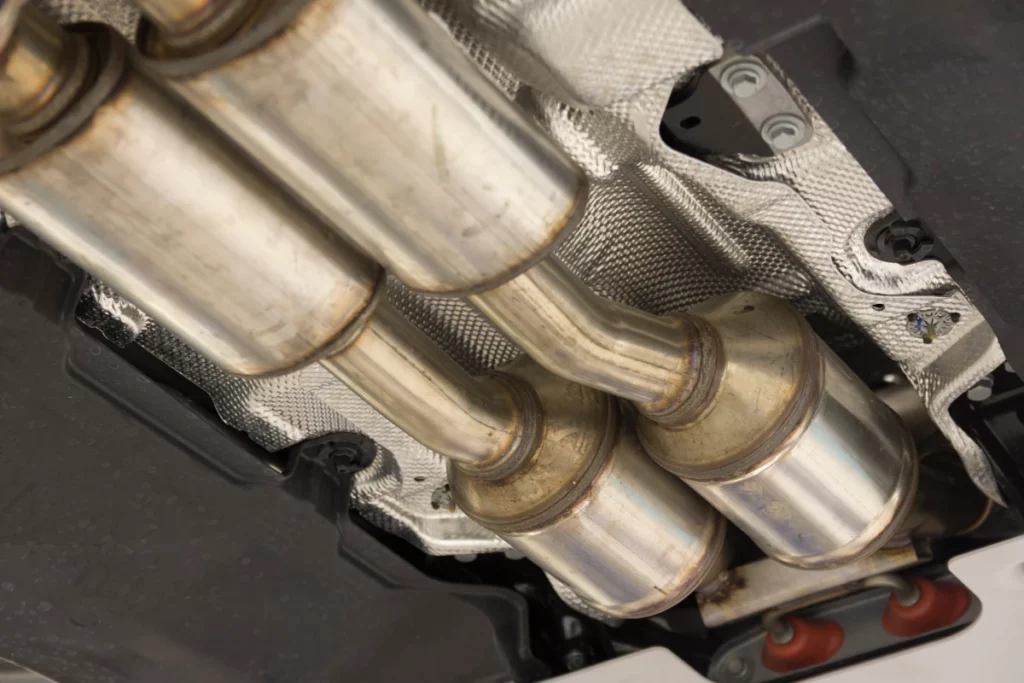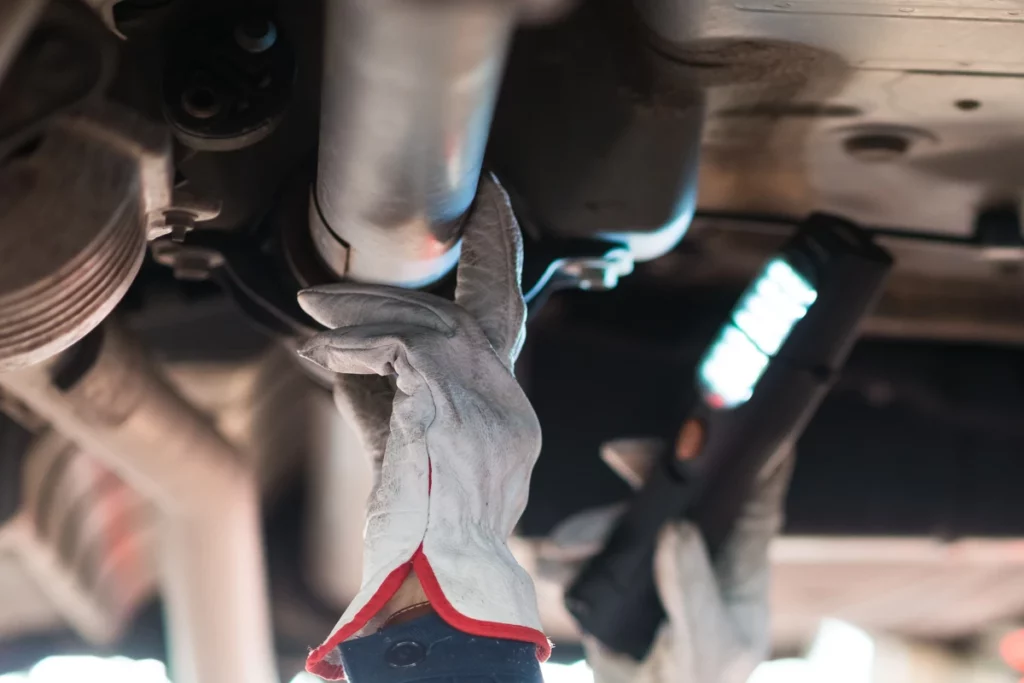Most exhaust manifolds are separate parts from the catalytic converters, which work together to release fumes from the engine.
What is the exhaust manifold? What is the catalytic converter? How do they prevent pollution and protect the health of the driver and passengers?
Let’s Find Out If The Exhaust Manifold Has Catalytic Converters
The exhaust manifold is not part of the catalytic converter. Rather, the catalytic converter is an essential part of the exhaust system, located close to the exhaust manifold. Each of the elements serves a different function to the exhaust system.
- Let's Find Out If The Exhaust Manifold Has Catalytic Converters
- Why Do Some Cars Have Catalytic Converters While Others Don't?
- How Do You Prevent Your Cars Catalytic Converter From Being Stolen?
- How Do You Know if Your Car Has a Catalytic Converter?
- Do You Have to Change the Catalytic Converter and Exhaust Manifold Together?
- What Are The Pros And Cons Of An Exhaust Manifold With Catalytic Converters?
- How Much Does An Exhaust Manifold With Catalytic Converters Cost?
- Closing Thoughts
- Sources

The catalytic converter is located beside the exhaust manifold in most vehicles. They both serve different but essential functions to the exhaust system.
The catalytic converter was first designed back in the 1950s by Eugene Houdry and Rodney Hagley. This device utilizes high heat and reactive metals to convert dangerous C01 into less dangerous C02.
The converter was later required to be added to all combustion engines in the 1970s. This helped mitigate pollution, especially in packed cities with high traffic concentrations. This can decrease air quality and negatively impact the ozone layer.
The catalytic converter and exhaust manifold work together to achieve this goal. The fumes are funneled from the engine and into the exhaust manifold. These fumes are safely moved to the catalytic converter, which converts the fumes to C02.
The exhaust manifold is an integral part of this process. Without it, the gas could escape, causing dangerous pollution or even a fire.
The catalytic converter isn’t part of the exhaust manifold. Instead, these systems are essential parts of the exhaust system and work to move dangerous fumes away from the engine.
Related:
- What Is The Purpose Of Exhaust Manifolds In A Car? (Explained)
- Do Car Exhaust Fumes Rise Or Fall? (Explained For Beginners)
- Can Car Exhaust Kill Grass, Plants, and Insects? (Might Surprise You)
Why Do Some Cars Have Catalytic Converters While Others Don’t?
All combustion engine vehicles have catalytic converters. This includes hybrid cars and diesel engines since both use a form of fuel combustion engine. The only standard vehicles without a catalytic converter are electric vehicles (EVs).
Most electric vehicles (EVs) do not use a hybrid motor to power the car. These vehicles rely solely on battery power.
Rather than combusting fuel, these cars store electricity from charging ports. The battery receives energy by plugging into the vehicle and can power the engine for between 60-90 miles.
Hybrid electric vehicles use fuel to power the vehicle as well as an electric-powered battery. These vehicles must have a catalytic converter since it produces C01.
All fuel injection engines are required by US law to have a catalytic converter. However, not all countries followed suit until more recently. South Africa and China only recently adopted these devices in their vehicles.
It’s unclear why these nations didn’t adopt catalytic converters sooner. However, it’s possible they resisted because catalytic converters are costly. New catalytic converters can cost over $1,000.00 new. They can resell for over $500, making them a target for thieves.
How Do You Prevent Your Cars Catalytic Converter From Being Stolen?
Parking in closed garages is the best way to prevent your catalytic converter from being stolen. People are more likely to steal catalytic converters from cars that are not in protected or closed areas. If you need to park outside, try to park in well-lit areas near buildings and places likely to have cameras.
It’s not too hard to remove the catalytic converter when it’s not connected to the exhaust manifold. Most thieves use a knife or hand saw to cut the catalytic converter away from the exhaust system’s pipes.
If you’re parking at home, try to keep your car near your house. If you can, park the car inside a locked garage to prevent theft. If this isn’t possible, cover your car with a tarp at night and tie it on.
This will likely discourage thieves from trying to cut away the small yet important car part.
How Do You Know if Your Car Has a Catalytic Converter?

Your car will have a catalytic converter if you purchase a vehicle in the US that was made before the 1970s. The only reason your fuel injection vehicle won’t have a catalytic converter is if someone removed it. This can occur because the converter was removed and not replaced or stolen.
The best way to know if your car doesn’t have a catalytic converter includes the following:
- Loud noises while driving
- Noxious fumes
- Smoke
- It’s not present in the exhaust system
You should check for the catalytic converter before purchasing a vehicle to ensure it hasn’t been stolen. Due to their expensive cost and complex build, they’re a target of thieves who can sell them for a high price.
It should be easy to tell if your car’s catalytic converter was stolen. The catalytic converter is usually a small white tube or box that should be evident. It should be located between the exhaust manifold and the exhaust system.
Additionally, most thieves use crude tools to cut out the converter from the pipe system. You should see that something was obviously missing and was cut out with a metal tool.
Do You Have to Change the Catalytic Converter and Exhaust Manifold Together?
You don’t have to change the catalytic converter with the exhaust manifold. The exhaust manifold and catalytic converters are separate parts of the exhaust system. Thus, they can be changed at different times, although damage to one typically leads to damage to the other.
The catalytic converter and exhaust manifold are separate components of the exhaust system. However, some damage to the exhaust system will harm both parts of the system. Therefore, depending on the damage to your exhaust system, the repairs can differ.
If the exhaust system cracked, it might have damaged the catalytic converter and exhaust manifold. In this situation, you should probably get both parts replaced. However, it’s up to the individual mechanic to make the diagnosis.
Some damage is unique to the catalytic converter. If the converter is cracked or isn’t getting hot enough, it can impact its performance. The catalytic converter will probably be replaced in these situations, but not the exhaust manifold.
Some new car models have the catalytic converter connected to the exhaust manifold. In this situation, you will have to replace both simultaneously.
What Are The Pros And Cons Of An Exhaust Manifold With Catalytic Converters?
The primary benefit of the catalytic converter is multifold. They prevent pollution and protect the driver of the car from dangerous fumes. The main advantage of having the catalytic converter attached to the exhaust manifold is it deters theft.
This question has two different answers. First, the catalytic converter’s benefit is preventing dangerous fumes from being expelled by the exhaust system. This makes driving safer and prevents hazardous emissions into the environment.
According to recent studies, the catalytic converter has helped alleviate pollutants by 90%. This has significantly impacted the environment in a positive way because it prevents air pollutants.
This is the benefit of a catalytic converter. However, what are the perks of having a catalytic converter connected to the exhaust manifold?
The main perk is it prevents theft. It’s much harder to cut away the exhaust manifold effectively without getting caught. However, the main benefit is that it increases the catalytic converter’s effectiveness.
They heat up faster when they’re connected to the exhaust manifold. This makes them more effective and converts pollutants more quickly.
However, the downside is if one gets damaged, the other part must be replaced too. This makes it more expensive to fix and more serious when one gets damaged. This is because they’re connected and are likely to break together.
How Much Does An Exhaust Manifold With Catalytic Converters Cost?
The catalytic converter is the most expensive part of the exhaust system. However, the exhaust manifold is costly too, and labor is an essential factor to consider. Every car model has different costs to consider, but the part combined can cost between $950-2,500.00.
Labor is an important factor when considering repairing or replacing your exhaust system. Labor is more expensive in certain parts of the U.S.A. and can range by couple hundred dollars.
According to J.D. Power, labor and parts can cost as much as $7,000.00.
The catalytic converter costs between $950-$2,5000. The price varies depending on the vehicle and can be more expensive for luxury vehicles.
The exhaust manifold costs between $700-$1,000 to replace. This price varies between small and large vehicles with more powerful engines. The more powerful the engine, the larger the exhaust manifold needs to be.
Closing Thoughts
The catalytic converter is one of the smallest parts of a vehicle, but it is vital. It converts the dangerous fumes caused by internal combustion and changes them to less harmful fumes. The exhaust manifold removes these fumes and expels them from the car’s exhaust system.
We hope this article helped you gain a better understanding of these systems. Protecting them from theft and damage is essential for your and the environment’s health.
Keep an eye on your vehicle and get it tuned periodically to ensure everything works well!
Sources
Wikipedia: Catalytic converter
Pony Parts: WHAT IS A CATALYTIC CONVERTER?
Carzing: Do All Cars Have Catalytic Converters?
EDF energy: How does the electric car engine work?
How Much is a Catalytic Converter in South Africa?
Reuters: China to require tougher new vehicle emission standards for 2020
JD Power: What Cars Have The Most Expensive Catalytic Converters?
The Spruce: How to Prevent Catalytic Converter Theft
CARID Why do some replacement exhaust manifolds come with catalytic converters?



